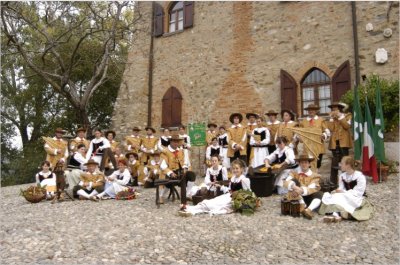Columbus Day in New York

Firlinfeu Folk Group
“LA BRIANZOLA”
OLGIATE MOLGORA (Lecco)
Who we are
Our folk group “La Brianzola” is made up of 40 members (players, singers and dancers) and every year participates in several festivals and folk seasons, both national and international.
The group was founded in 1858; in 1959 it was renewed and a ballet company was added, along with the traditional 1600’s peasant holiday costumes. “La Brianzola” is inspired by Alessandro Manzoni’s “The Betrothed”, which is set mostly in Lecco and the region of Brianza around the year 1600, as well as by the region’s costumes and traditions.

Where are we from?
We are from Olgiate Molgora, a small town near Lecco and swathed in the Brianza, a typical hilly land stretching among Como, Lecco and Monza, in the south of Lecco branch of Lario, along Adda river.
What is the firlinfeu?
In Brianza dialect, “firlinfeu” refers both to the typical wind instrument, a reed whistle, and to the players of it. In Como and Lecco provinces there are many firlinfeu groups keeping alive this special and ancient musical tradition: even the Greek mythology mentions it, referring to the sad tale of the unfortunate love between Pan and the nymph Siringa. Today local artisans create this instrument with the reeds growing around the Brianza lakes.
Our music, dances and songs
“La Brianzola” has a rich repertory of traditional music, songs and dances, from 1600 to 1900. All the music is played with our characteristic reed whistle “firlinfeu” on different tunes, creating an original polyphonic effect. On the basis of this sound we play many kinds of waltzes, mazurkas, polkas and marches of different epochs. Both dances and songs represent the daily life of Brianza peasants, describing some moments of work in the fields and in the spinning mills, and some traditional festivals.
Costumes
Our costumes are inspired by the typical holiday clothing of Brianza peasants of 1600, similar to those worn by Renzo and Lucia in Manzoni’s “The Betrothed”. The colorful decorations represent their main features and symbolize various moments of the Catholic ritual, along with the Spanish influence which was strong in Lecco and its surroundings in that period.
The male costume includes the traditional felt hat with a heron’s feather, a cut-sleeve jacket in order to let the shirt’s puffed sleeves out, and a coat with half-moon padded shoulders, typical of that period of Spanish domination. Then we have knee-length velvet trousers, with colored ribbons and white socks, and seamless leather shoes.
The female costume presents the typical hair clip made of silver “little swords”, which was a sort of identity card of the girl who wore it: from the number of little swords you could tell her age and marital statue, as well as the village where she came from. The clothing is composed of a white bulky shirt with local lace, a black bodice (on Sundays it was decorated with a coral necklace and ribbons colored according to the liturgy). Then we find a one-color skirt, embellished with colored ribbons, a white underskirt, a white apron and a colored foulard. Finally, long white socks and wooden clogs which, along with the little swords hair clip and the firlinfeu, are the symbols of the Lecco Lake and Adda River area.

